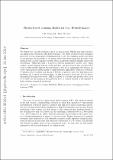Physics-Based Learning Models for Ship Hydrodynamics
Author(s)
Weymouth, Gabriel D.; Yue, Dick K. P.
DownloadYue_Physics-based learning.pdf (1.111Mb)
OPEN_ACCESS_POLICY
Open Access Policy
Creative Commons Attribution-Noncommercial-Share Alike
Terms of use
Metadata
Show full item recordAbstract
We present the concepts of physics-based learning models (PBLM) and their relevance and application to the field of ship hydrodynamics. The utility of physics-based learning is motivated by contrasting generic learning models for regression predictions, which do not presume any knowledge of the system other than the training data provided with methods such as semi-empirical models, which incorporate physical insights along with data-fitting. PBLM provides a framework wherein intermediate models, which capture (some) physical aspects of the problem, are incorporated into modern generic learning tools to substantially improve the predictions of the latter, minimizing the reliance on costly experimental measurements or high-resolution high-fidelity numerical solutions. To illustrate the versatility and efficacy of PBLM, we present three wave-ship interaction problems: 1) at speed waterline profiles; 2) ship motions in head seas; and 3) three-dimensional breaking bow waves. PBLM is shown to be robust and produce error rates at or below the uncertainty in the generated data at a small fraction of the expense of high-resolution numerical predictions.
Date issued
2013-03Department
Massachusetts Institute of Technology. Department of Mechanical EngineeringJournal
Journal of Ship Research
Publisher
The Society of Naval Architects and Marine Engineers
Citation
Weymouth, Gabriel D., and Dick K.P. Yue. “Physics-Based Learning Models for Ship Hydrodynamics.” Journal of Ship Research 57, no. 1 (March 1, 2013): 1–12.
Version: Original manuscript
ISSN
00224502
15420604